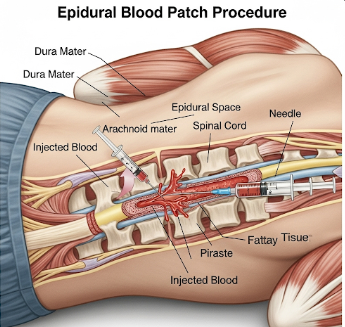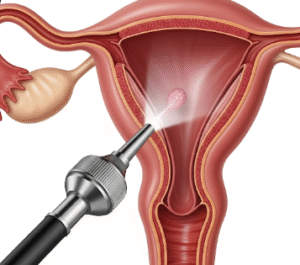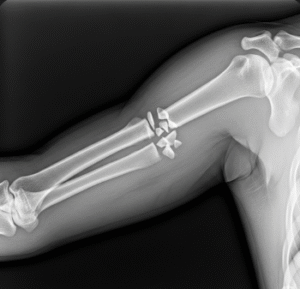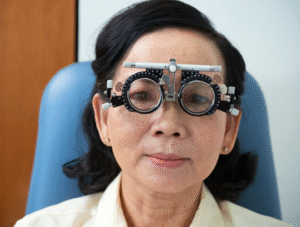Overview
An epidural blood patch (EBP) is a medical procedure used to treat spinal headaches caused by cerebrospinal fluid (CSF) leakage, often after a lumbar puncture (spinal tap) or epidural anesthesia. The procedure involves injecting a small amount of the patient’s own blood into the epidural space to seal the leak, relieve pain, and restore normal CSF pressure.
In South Korea, epidural blood patch procedures are performed in advanced neurology and anesthesia centers, using high-precision imaging, sterile techniques, and expert anesthesiologists to ensure effective and safe outcomes.
What is an Epidural Blood Patch?
An epidural blood patch is a therapeutic procedure designed to stop CSF leaks that cause post-dural puncture headaches.
Purpose:
- Seal CSF leaks in the epidural space
- Relieve debilitating spinal headaches
- Prevent further complications such as low CSF pressure syndromes
- Avoid prolonged pain and mobility limitations
Common indications:
- Headache after lumbar puncture or spinal anesthesia
- Persistent post-spinal headache unresponsive to conservative therapy
- Symptoms such as neck stiffness, nausea, or visual disturbances due to CSF leakage
What are the Benefits?
The procedure offers several diagnostic and therapeutic benefits:
✔ Rapid relief from spinal headaches caused by CSF leaks.
✔ Minimally invasive with high success rates.
✔ Avoids prolonged discomfort and hospitalization.
✔ Helps prevent secondary complications of low CSF pressure.
✔ Quick recovery allowing early return to daily activities.
Procedure Details
1) How should I prepare for an Epidural Blood Patch?
- Medical evaluation: Review your medical history, medications, and allergies
- Lab tests: Blood count, coagulation profile, and infection screening
- Hydration: Maintain proper fluid intake prior to the procedure
- Consent and counseling: Understand the procedure, expected relief, potential risks, and recovery
- Fasting: Typically not required unless sedation is planned
Korean hospitals provide personalized pre-procedure assessment, sterile preparation, and patient counseling to ensure safety and comfort.
2) What happens during an Epidural Blood Patch?
- Positioning: Patient lies on their side or sits with back curved to open the epidural space
- Blood draw: Small amount of patient’s blood is drawn from a vein
- Injection: Blood is slowly injected into the epidural space at or near the site of the CSF leak
- Monitoring: Patient is observed for immediate relief and any adverse reactions
- Duration: Usually 20–30 minutes
Advanced Korean centers use fluoroscopy or ultrasound guidance to enhance precision, reduce risk, and improve effectiveness.
3) What happens after an Epidural Blood Patch?
- Immediate: Patient may experience relief within minutes to hours
- Post-procedure care: Lie flat for 1–2 hours; avoid strenuous activity for 24–48 hours
- Follow-up: Monitor for headache recurrence or neurological symptoms
- Additional patches: Rarely, a second EBP may be required if the first is partially effective
Risks / Benefits
Potential Risks:
- ➤ Back soreness or mild pain at injection site
- ➤ Temporary numbness or tingling in legs
- ➤ Infection at the injection site (rare)
- ➤ Bleeding or hematoma formation (rare)
- ➤ Nerve irritation or, very rarely, neurological complications
Major Benefits:
- ✔ High success rate for relief of post-spinal headaches
- ✔ Minimally invasive with quick procedure time
- ✔ Prevents prolonged CSF leakage complications
- ✔ Outpatient procedure with rapid recovery
- ✔ Enhances quality of life by alleviating debilitating pain
Recovery and Outlook
- Immediate: Relief may be felt within hours; mild back soreness is normal
- Short-term: Avoid heavy lifting, bending, or straining for 24–48 hours
- Follow-up: Usually assessed within a few days to ensure complete symptom resolution
- Long-term: Most patients achieve full recovery after a single blood patch, though rare cases may require additional interventions
South Korean hospitals provide structured post-procedure monitoring, pain management, and patient guidance to ensure a smooth recovery.
When To Call the Doctor
Contact your doctor if you notice:
- ➤ Headache persists or worsens after the patch
- ➤ Numbness, weakness, or tingling in the legs
- ➤ Fever, redness, or discharge at the injection site
- ➤ Severe back pain or signs of neurological complications
- ➤ Any unusual symptoms post-procedure
Best Korea Option / Process
South Korea offers world-class epidural blood patch services due to:
- Experienced anesthesiologists and pain management specialists
- Use of fluoroscopy or ultrasound guidance for precise placement
- Minimally invasive, safe, and effective technique
- Structured pre- and post-procedure care
- Rapid symptom relief with high patient satisfaction
- International patient support including consultation, scheduling, and follow-up
Top hospitals for Epidural Blood Patch in Korea:
- Samsung Medical Center, Seoul – Pain Management & Anesthesia
- Asan Medical Center, Seoul – Advanced Pain and Spine Center
- Severance Hospital (Yonsei University Health System) – Pain Intervention and Anesthesia
- Seoul National University Hospital – Neurology and Pain Management













